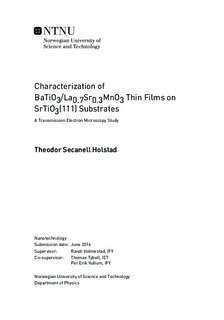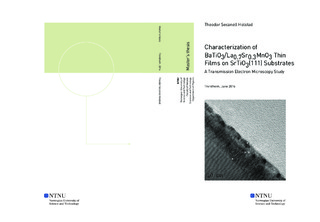| dc.description.abstract | In this work, an oxide thin film system was investigated by using transmission electron microscopy (TEM) techniques. It is of great interest to study such systems due to their current applications as well as potential future applications in electronic devices. One sample consists of a 10 nm BaTiO3 thin film deposited on a 10 nm La0.7Sr0.3MnO3 thin film deposited on a (111)-oriented SrTiO3 substrate, in short BTO(10nm)/LSMO(10nm)/STO(111). The other sample is the same, except for having a BTO film of thickness 3 nm. BTO is a tetragonal perovskite with space group P4mm (99) and STO is cubic perovskite with space group Pm-3m (221). LSMO is a rhombohedral perovskite with space group R-3c (167) in bulk form. TEM specimens with cross-sectional and plan-view geometries were prepared using a mechanical polishing routine combined with precision ion polishing, and by a focused ion-beam (FIB) procedure. High-resolution TEM (HR-TEM), brightfield TEM (BF-TEM), scanning precession electron diffraction (SPED), scanning transmission electron microscopy electron energy loss spectroscopy (STEM-EELS), high angle annular dark-field STEM (HAADF-STEM), geometrical phase analysis (GPA) and selected area diffraction (SAD) were performed on the Jeol-Jem 2100F and the Jeol-Jem ARM 200F.
The data obtained in this work suggests that the BTO thin films are in a ferroelectric mono-domain state. Due to a large amount of edge dislocations, it was not possible to map the precise positions of the Ti columns and thus the ferroelectric polarization. Such dislocations occur naturally when there is misfit between a thin film and the substrate, and the thin film is relaxed. Since the crystallographic difference between ferroelectric domains in BTO is very small, it becomes very difficult to deconvolve the strain fields around dislocations from a potential ferroelectric domain structure.
The LSMO thin film was found to have undergone a reduction in symmetry from its bulk structure. This conclusion was reached based on the fact that additional super-reflections were observed in the SAD patterns. Based on the literature available on LSMO thin film systems deposited on STO(111), it was concluded that LSMO has undergone a monoclinic distortion. However, a precise determination of its space group is beyond the scope of this work. Furthermore, two domain states were found in LSMO.
The EELS analysis indicates that LSMO has a large amount of oxygen vacancies and a Mn oxidation state far below its bulk value. In addition, a tensile strain in the direction normal to the thin film interface was observed in the GPA analysis, which is inconsistent with X-ray diffraction measurements done on the same system. This discrepancy is probably linked to the large amount of oxygen vacancies in LSMO, which may dramatically alter its behavior. The oxygen vacancies may have been created during the TEM specimen preparation in the FIB. Another explanation is that the oxygen vacancies were induced by the electron beam in the TEM, as this has been observed to occur in LSMO in several earlier studies. The oxygen vacancies are probably not ordered, since the observed super-reflections were not consistent with any known ordering, such as the Brownmillerite phases.
In conclusion, an important and interesting oxide thin film system has been characterized using TEM techniques. An important observation is the fact that there are many obstacles to extracting the relevant data. Firstly, misfit dislocations are not easily avoided, but make it difficult to map small changes in the positions of the Ti columns. Secondly, the electron beam and the specimen preparation may induce oxygen vacancies that dramatically alter the structure of LSMO. Hopefully, the findings in this work will give an insight into the structure-property relations of these systems, as well as an overview of the challenges associated with studying them. A recommendation for the future is to produce specimens using several different types of preparation techniques, to find out how these affect the specimen quality. It may be necessary to alter the parameters used during the thin film synthesis as well. For example, annealing the sample in an oxygen rich atmosphere after synthesis and after preparation in the FIB to reduce the amount of oxygen vacancies. Finally, using a low voltage and shorter exposure times in the TEM may help reduce the creation of oxygen vacancies in LSMO. | |

